Limited Utilization of an External Carbon Source in a Rotating Electro-Biological Disc Contactor (REBDC)
Abstract
1. Introduction
- COD: 50.07–75.82 mg O2/L (Greenhouse 1) and 37.35–78.12 mg O2/L (Greenhouse)
- TN: 403.59–614.89 mg N/L (Greenhouse 1) and 270.00–577.40 mg N/L (Greenhouse 2)
- TP: 35.44–78.00 mg P/L (Greenhouse 1) and 54.10–104.00 mg P/L (Greenhouse 2)
- EC: 3.53–6.93 mS/cm (Greenhouse 1) and 4.94–6.94 mS/cm (Greenhouse 2).
- At current densities above 2.5 A/m2, hydrogenotrophic denitrification became the dominant nitrogen removal mechanism, while heterotrophic denitrification and electrochemical nitrate reduction were suppressed.
- At a 24-h HRT and 2.5 A/m2 current density, phosphorus removal efficiency exceeded 99%, while nitrogen removal efficiency reached 38.7%.
- Higher current densities (>2.5 A/m2) increased the wastewater temperature above 33.5 °C.
2. Materials and Methods
2.1. Wastewater Characteristics
- Chemical oxygen demand (COD),
- Total nitrogen (TN),
- Nitrate nitrogen (N-NO3),
- Total phosphorus (TP),
- Electrical conductivity (EC).
2.2. Reactor Setups—Rotating Biological Disc Contactor (RBDC) and Rotating Electro-Biological Disc Contactor (REBDC)
- A cylindrical biological tank with a working volume of 2.0 L,
- A horizontal shaft equipped with flat PVC discs (diameter: 22 cm),
- Aluminum plate electrodes mounted on the tank walls, acting as an anode,
- A DC power supply (HANTEK PPS2116A, Qingdao, China) providing adjustable constant current densities ranging from 0 to 10 A/m2.
2.3. External Carbon Source Dosing
2.4. Operational Parameters
- Phase I—biological phase; operation of RBDC (without electric current flow), with external carbon source dosing (C:N = 0.5, 1.0, 2.0, and 3.0)
- Phase II—electro-biological phase; operation of REBDC with external carbon source dosing (C:N = 0.5, 1.0, 2.0, and 3.0).
2.5. Analytical Methods
3. Results and Discussion
3.1. pH
3.2. The Electrical Conductivity (EC)
3.3. Total Phosphorus (TP)
3.4. Total Nitrogen (TN)
3.5. Nitrites and Ammonium Nitrogen
3.6. COD
4. Conclusions
- Phosphorus removal efficiency in the biological reactor was significantly lower than in the electrobiological reactor because phosphorus removal in the biological reactor was primarily associated with biofilm formation, a process of low efficiency.
- Phosphorus removal efficiencies above 90% were obtained in the electro-biological reactor at C/N ratios of 0.5, 1.0, and 2.0. At C/N = 3.0, the efficiency exceeded 83%. This reactor performance resulted from two mechanisms: phosphorus uptake linked to biofilm biomass growth and, more importantly, electrocoagulation.
- High C/N ratios reduced phosphorus removal efficiency because elevated organic substrate levels in the biofilm promoted the growth of GAOs, which outcompeted PAOs.
- The efficiency of total nitrogen (TN) removal increased with the dose of organic substrate fed to reactors of both types. In the electrobiological reactor, the TN removal efficiency was more than 9 times higher at C/N = 2.0 and more than 11 times higher at C/N = 3.0 compared to the values obtained at C/N = 0.5.
- At the highest substrate dose (C/N = 3.0), the TN concentration was 263.0 mg N/L in the effluent from RBDC (56.7% TN removal efficiency) and 215.0 mg N/L in that from REBDC (64.8% efficiency).
- The higher nitrogen removal rates were achieved in the electrobiological reactor, as nitrogen removal in the biological reactor was achieved upon heterotrophic denitrification and nitrogen incorporation into the biomass. In the electrobiological reactor, the efficiency of nitrogen removal was also influenced by hydrogenotrophic denitrification and electrochemical nitrate reduction due to the electric current flow.
- The extent of organic compound utilization in the electro-biological reactor was higher than in the biological reactor.
- In the reactor operated at a C/N = 0.5, the COD concentration in the effluent (87 mg O2/L) exceeded that in the influent (51 mg O2/L), indicating substantial, though incomplete, utilization of the external carbon source.
- At C/N ratios of 0.5 and 1.0, nitrogen removal efficiencies remained very low, not exceeding dozen percent. A tangible improvement was observed only at C/N = 2.0, where the REBDC reactor reached 56.0%, and at C/N = 3.0, where the efficiency exceeded 65%. Despite this enhancement, considerable residual organic carbon persisted in the effluent.
- To enhance nitrogen removal in the electrobiological reactor while ensuring more efficient utilization of the external carbon source, the technological approach should involve either extending the hydraulic retention time or implementing a multi-stage REBDC system. Further research should be carried out in this respect.
Author Contributions
Funding
Data Availability Statement
Conflicts of Interest
Abbreviations
| BER | Bio-electrochemical reactor |
| REBDC | Rotating electro-biological disc contactor |
| RBDC | Rotating biological disc contactor |
| BDPs | Biodegradable polymers |
| HRT | Hydraulic retention time |
| TN | Total nitrogen |
| TP | Total phosphorus |
| DOC | Dissolved organic carbon |
| EC | Electrical conductivity |
| PAOs | Polyphosphate-accumulating organisms |
| GAOs | Glycogen-accumulating organisms |
References
- Mielcarek, A.; Rodziewicz, J.; Janczukowicz, W.; Dobrowolski, A. Analysis of wastewater generated in greenhouse soilless tomato cultivation in central Europe. Water 2019, 11, 2538. [Google Scholar] [CrossRef]
- van der Salm, C.; Voogt, W.; Beerling, E.; van Ruijven, J.; van Os, E. Minimising emissions to water bodies from NW European greenhouses; with focus on Dutch vegetable cultivation. Agric. Water Manag. 2020, 242, 106398. [Google Scholar] [CrossRef]
- Regulation of the Minister of Maritime Economy and Inland Navigation of July 12, 2019 on Substances Particularly Harmful to the Aquatic Environment and Conditions to Be Met When Introducing Sewage into Waters or into the Ground, as Well as When Discharging Rainwater or Snowmelt into Waters or into Water Equipment. Dz. U. (J. Laws) 2019, 1311. Available online: https://isap.sejm.gov.pl/isap.nsf/DocDetails.xsp?id=WDU20190001311 (accessed on 23 September 2025). (In Polish)
- Du, J.; Xu, B.; Ma, L.; Jiao, H.; Tian, B.; Li, K.; Lian, J. Study on denitrification of hydroponic wastewater reverse osmosis concentrate using sulfur-autotrophic denitrification. J. Environ. Chem. Eng. 2023, 11, 111195. [Google Scholar] [CrossRef]
- Kwon, M.J.; Hwang, Y.; Lee, J.; Ham, B.; Rahman, A.; Azam, H.; Yang, J.-S. Waste nutrient solutions from full-scale open hydroponic cultivation: Dynamics of effluent quality and removal of nitrogen and phosphorus using a pilot-scale sequencing batch reactor. J. Environ. Manag. 2021, 281, 111893. [Google Scholar] [CrossRef] [PubMed]
- Gu, X.; Leng, J.; Zhu, J.; Zhang, K.; Zhao, J.; Wu, P.; Xing, Q.; Tang, K.; Li, X.; Hu, B. Influence mechanism of C/N ratio on heterotrophic nitrification- aerobic denitrification process. Bioresour. Technol. 2022, 343, 126116. [Google Scholar] [CrossRef]
- Zhao, B.; Sun, Z.; Liu, Y. An overview of in-situ remediation for nitrate in groundwater. Sci. Total Environ. 2022, 804, 149981. [Google Scholar] [CrossRef]
- Henze, M.; Harremoës, P.; Jes La Cour, J.; Arvin, E. Wastewater Treatment. Biological and Chemical Processes; Kielce University of Technology Publishing House: Kielce, Poland, 2002. (In Polish) [Google Scholar]
- Lee, K.C.; Rittmann, B.E. Effects of pH and precipitation on autohydrogenotrophic denitrification using the hollow-fiber membrane-biofilm reactor. Water Res. 2003, 37, 1551–1556. [Google Scholar] [CrossRef]
- Mansell, B.O.; Schroeder, E.D. Hydrogenotrophic denitrification in a microporous membrane bioreactor. Water Res. 2002, 36, 4683–4690. [Google Scholar] [CrossRef]
- Peng, Y.-Z.; Ma, Y.; Wang, S.-Y. Denitrification potential enhancement by addition of external carbon sources in a pre-denitrification process. J. Environ. Sci. 2007, 19, 284–289. [Google Scholar] [CrossRef] [PubMed]
- Chen, H.B.; Wang, D.B.; Li, X.M.; Yang, Q.; Zeng, G.M. Enhancement of post-anoxic denitrificationfor biological nutrient removal: Effect of different carbon sources. Environ. Sci. Pollut. Res. 2015, 22, 5887–5894. [Google Scholar] [CrossRef]
- Rodziewicz, J.; Mielcarek, A.; Janczukowicz, W.; Jóźwiak, T.; Struk–Sokołowska, J.; Bryszewski, K. The share of electrochemical reduction, hydrogenotrophic and heterotrophic denitrification in nitrogen removal in rotating electrobiological contactor (REBC) treating wastewater from soilless cultivation systems. Sci. Total Environ. 2019, 683, 21–28. [Google Scholar] [CrossRef] [PubMed]
- Mielcarek, A.; Rodziewicz, J.; Janczukowicz, W.; Dąbrowska, D.; Ciesielski, S.; Thornton, A.; Struk-Sokołowska, J. Citric acid application for denitrification process support in biofilm reactor. Chemosphere 2017, 171, 512–519. [Google Scholar] [CrossRef] [PubMed]
- Lee, D.-U.; Lee, I.-S.; Choi, Y.-D.; Bae, J.-H. Effects of external carbon source and empty bed contact time on simultaneous heterotrophic and sulfur-utilizing autotrophic denitrification. Process Biochem. 2001, 36, 1215–1224. [Google Scholar] [CrossRef]
- Fernández, F.J.; Castro, M.C.; Villasenor, J.; Rodríguez, L. Agro-food wastewaters as external carbon source to enhance biological phosphorus removal. Chem. Eng. J. 2011, 166, 559–567. [Google Scholar] [CrossRef]
- Fu, X.; Hou, R.; Yang, P.; Qian, S.; Feng, Z.; Chen, Z.; Wang, F.; Yuan, R.; Chen, H.; Zhou, B. Application of external carbon source in heterotrophic denitrification of domestic sewage: A review. Sci. Total Environ. 2022, 817, 153061. [Google Scholar] [CrossRef]
- Zhang, Y.; Wang, X.C.; Cheng, Z.; Li, Y.; Tang, J. Effect of fermentation liquid from food waste as a carbon source for enhancing denitrification in wastewater treatment. Chemosphere 2016, 144, 689–696. [Google Scholar] [CrossRef]
- Cui, H.; Feng, Y.; Yin, Z.; Qu, K.; Wang, L.; Li, J.; Jin, T.; Bai, T.; Cui, Z. Organic carbon release, denitrification performance and microbial community of solid-phase denitrification reactors using the blends of agricultural wastes and artificial polymers for the treatment of mariculture wastewater. Ecotoxicol. Environ. Saf. 2023, 255, 114791. [Google Scholar] [CrossRef]
- Liu, D.; Li, J.; Li, C.; Deng, Y.; Zhang, Z.; Ye, Z.; Zhu, S. Poly(butylene succinate)/bamboo powder blends as solid-phase carbon source and biofilm carrier for denitrifying biofilters treating wastewater from recirculating aquaculture system. Sci. Rep. 2018, 8, 3289. [Google Scholar] [CrossRef]
- Yang, X.L.; Jiang, Q.; Song, H.L.; Gu, T.T.; Xia, M.Q. Selection and application of agricultural wastes as solid carbon sources and biofilm carriers in MBR. J. Hazard. Mater. 2015, 283, 186–192. [Google Scholar] [CrossRef]
- Kłobukowska, K.; Rodziewicz, J.; Mielcarek, A.; Bryszewski, K.; Janczukowicz, W.; Bugajski, P.; Jóźwiakowski, K.; Operacz, A. Novel materials as exogenous carbon sources for denitrifying biofilters. Appl. Sci. 2024, 14, 176. [Google Scholar] [CrossRef]
- Krzemieniewski, M.; Rodziewicz, J. Nitrogen compounds removal in a rotating electrobiological contactor. Environ. Eng. Sci. 2005, 22, 816–822. [Google Scholar] [CrossRef]
- PN-ISO 6060:2006; Water Quality—Determination of the Chemical Oxygen Demand. Polish Committee for Standardization: Warsaw, Poland, 2006.
- PN-EN 12260:2005; Water Quality—Determination of Nitrogen—Determination of Bound Nitrogen (TN), Following Oxidation To Nitrogen Oxides. Polish Committee for Standardization: Warsaw, Poland, 2005.
- PN-EN ISO 10304-1:2009; Water Quality—Determination of Dissolved Anions by Liquid Chromatography of Ions—Part 1: Determination of Bromide, Chloride, Fluoride, Nitrate, Nitrite, Phosphate and Sulfate. Polish Committee for Standardization: Warsaw, Poland, 2009.
- PN-EN ISO 6878:2006; Water Quality—Determination of Phosphorus—Ammonium Molybdate Spectrometric Method. Polish Committee for Standardization: Warsaw, Poland, 2006.
- PN-EN 27888:1999; Water Quality—Determination of Electrical Conductivity. Polish Committee for Standardization: Warsaw, Poland, 1999.
- Ghafari, S.; Hasan, M.; Aroua, M.K. Improvement of autohydrogenotrophic nitrite reduction rate through optimization of pH and bicarbonate dose in a batch experiments. J. Biosci. Bioeng. 2009, 107, 275–280. [Google Scholar] [CrossRef] [PubMed]
- Mousavi, S.A.R.; Ibrahim, S.; Aroua, M.K.; Ghafari, S. Development of nitrate elimination by autohydrogenotrophic bacteria in bio-electrochemical reactors—A review. Biochem. Eng. J. 2012, 67, 251–264. [Google Scholar] [CrossRef]
- Di Capua, F.; Pirozzi, F.; Lens, P.N.L.; Esposito, G. Electron donors for autotrophic denitrification. Chem. Eng. J. 2019, 362, 922–937. [Google Scholar] [CrossRef]
- Prosnansky, M.; Sakakibara, Y.; Kuroda, M. High-rate denitrification and SS rejection by biofilm electrode reactor (BER) combined with microfiltration. Water Res. 2002, 36, 4801–4810. [Google Scholar] [CrossRef] [PubMed]
- Rahimi, S.; Modin, O.; Mijakovic, I. Technologies for biological removal and recovery of nitrogen from wastewater. Biotechnol. Adv. 2020, 43, 107570. [Google Scholar] [CrossRef]
- Glass, C.; Silverstein, J. Denitrification kinetics of high nitrate concentration water: pH effect on inhibition and nitrite accumulation. Water Res. 1998, 32, 831–839. [Google Scholar] [CrossRef]
- Rezania, B.; Cicek, N.; Oleszkiewicz, J.A. Kinetics of hydrogen-dependent denitrification under varying pH and temperature conditions. Biotechnol. Bioeng. 2005, 92, 900–906. [Google Scholar] [CrossRef]
- Kurt, M.; Dunn, J.; Bourne, J.R. Biological denitrification of drinking water using autotrophic organisms with H2 in a fluidized-bed biofilm reactor. Biotechnol. Bioeng. 1987, 29, 493–501. [Google Scholar] [CrossRef]
- Huang, B.; Feng, H.; Wang, M.; Li, N.; Cong, Y.; Shen, D. The effect of C/N ratio on nitrogen removal in a bioelectrochemical system. Bioresour. Technol. 2013, 132, 91–98. [Google Scholar] [CrossRef]
- Huang, W.; Gong, B.; Wang, Y.; Lin, Z.; He, L.; Zhou, J.; He, Q. Metagenomic analysis reveals enhanced nutrients removal from low C/N municipal wastewater in a pilot-scale modified AAO system coupling electrolysis. Water Res. 2020, 173, 115530. [Google Scholar] [CrossRef]
- Zhang, L.; Hao, S.; Wang, Y.; Lan, S.; Dou, Q.; Peng, Y. Rapid start-up strategy of partial denitrification and microbially driven mechanism of nitrite accumulation mediated by dissolved organic matter. Bioresour. Technol. 2021, 340, 125663. [Google Scholar] [CrossRef]
- Hassard, F.; Biddle, J.; Cartmell, E.; Jefferson, B.; Tyrrel, S.; Stephenson, T. Rotating biological contactors for wastewater treatment—A review. Process Saf. Environ. 2015, 94, 285–306. [Google Scholar] [CrossRef]
- Mahto, K.U.; Das, S. Bacterial biofilm and extracellular polymeric substances in the moving bed biofilm reactor for wastewater treatment: A review. Bioresour. Technol. 2022, 345, 126476. [Google Scholar] [CrossRef]
- Gaspar, E.; Munteanu, I.; Sintea, S. Removal of N and P in a Rotating Biological Contactor Plant: Case Study Agnita, Romania. Water 2022, 14, 3670. [Google Scholar] [CrossRef]
- Rodziewicz, J.; Mielcarek, A.; Bryszewski, K.; Janczukowicz, W.; Kłobukowska, K. Energy consumption for nutrient removal from high-nitrate and high-phosphorus wastewater in aerobic and anaerobic bioelectrochemical reactors. Energies 2022, 15, 7251. [Google Scholar] [CrossRef]
- Lagum, A.A. Integrating electrochemical and biological phosphorus removal processes via electrokinetic-based technology. J. Environ. Chem. Eng. 2021, 9, 106609. [Google Scholar] [CrossRef]
- Hackbarth, M.; Gescher, J.; Horn, H.; Reiner, J.E. A scalable, rotating disc bioelectrochemical reactor (RDBER) suitable for the cultivation of both cathodic and anodic biofilms. Bioresour. Technol. Rep. 2023, 21, 101357. [Google Scholar] [CrossRef]
- Rittmann, B.E.; McCarty, P.L. Environmental Biotechnology: Principles and Applications; McGraw-Hill Education: New York, NY, USA, 2020. [Google Scholar]
- Chen, Y.Z.; Zhang, L.J.; Ding, L.Y.; Zhang, Y.Y.; Wang, X.S.; Qiao, X.J.; Pan, B.Z.; Wang, Z.W.; Xu, N.; Tao, H.C. Sustainable treatment of nitrate-containing wastewater by an autotrophic hydrogen-oxidizing bacterium. Environ. Sci. Ecotechnol. 2022, 9, 100146. [Google Scholar] [CrossRef] [PubMed]
- Pan, Y.; She, D.; Shi, Z.; Cao, T.; Xia, Y.; Shan, J. Salinity and high pH reduce denitrification rates by inhibiting denitrifying gene abundance in a saline-alkali soil. Sci. Rep. 2023, 13, 2155. [Google Scholar] [CrossRef]
- González, V.L.; Dombrowski, P.M.; Lee, M.D.; Ramsburg, C.A. The Influence of pH on Subsurface Denitrification Stimulated with Emulsified Vegetable Oil. Water 2023, 15, 883. [Google Scholar] [CrossRef]
- Salem, Z.; Lebik, H.; Cherafa, W.K.; Allia, K. Valorisation of olive pits using biological denitrification. Desalination 2007, 204, 72–78. [Google Scholar] [CrossRef]
- Dash, B.P.; Chaudhari, S. Electrochemical denitrification of simulated ground water. Water Res. 2005, 39, 4065–4072. [Google Scholar] [CrossRef]
- Ding, A.; Zheng, P.; Zhang, M.; Zhang, Q. Impacts of electron donor and acceptor on the performance of electrotrophic denitrification. Environ. Sci. Pollut. Res. 2017, 24, 19693–19702. [Google Scholar] [CrossRef]
- Li, M.; Feng, C.P.; Zhang, Z.N.; Lei, X.H.; Chen, R.Z.; Yang, Y.N.; Sugiura, N. Simultaneous reduction of nitrate and oxidation by-products using electrochemical method. J. Hazard. Mater. 2009, 171, 724–730. [Google Scholar] [CrossRef] [PubMed]
- Zhang, J.M.; Feng, C.P.; Hong, S.Q.; Hao, H.L.; Yang, Y.N. Behavior of solid carbon sources for biological denitrification in groundwater remediation. Water Sci. Technol. 2012, 65, 1696–1704. [Google Scholar] [CrossRef] [PubMed]
- Metcalf & Eddy, Inc. Wastewater Engineering: Treatment and Resource Recovery, 5th ed.; McGraw Hill: New York, NY, USA, 2014. [Google Scholar]
- Sanjrani Manzoor Ahmed, B.Z.; Rind, S.; Rani, K. Systematic review: External carbon source for biological denitrification for wastewater. Biotechnol. Bioeng. 2023, 120, 642–658. [Google Scholar] [CrossRef] [PubMed]
- Hao, R.X.; Li, S.M.; Li, J.B.; Meng, C.C. Denitrification of simulated municipal wastewater treatment plant effluent using a three-dimensional biofilm-electrode reactor: Operating performance and bacterial community. Bioresour. Technol. 2013, 143, 178–186. [Google Scholar] [CrossRef]
- Lin, X.; Yin, H.; Wang, L.; Chen, Y.; Zhao, F.; Pu, Y.; Tang, X. Study of a three-dimensional biofilm-electrode reactor (3D-BER) that combined heterotrophic and autotrophic denitrification (HAD) to remove nitrate from water. RSC Adv. 2023, 21, 14675–14684. [Google Scholar] [CrossRef]
- Tong, S.; Zhang, B.; Feng, C.; Zhao, Y.; Chen, N.; Hao, C.; Pu, J.; Zhao, L. Characteristics of heterotrophic/biofilm-electrode autotrophic denitrification for nitrate removal from groundwater. Bioresour. Technol. 2013, 148, 121–127. [Google Scholar] [CrossRef]
- Wu, L.; Wei, W.; Xu, J.; Chen, X.; Liu, Y.; Peng, L.; Wang, D.; Ni, B.-J. Denitrifying biofilm processes for wastewater treatment: Developments and perspective. Environ. Sci. Water Res. Technol. 2021, 7, 40–67. [Google Scholar] [CrossRef]
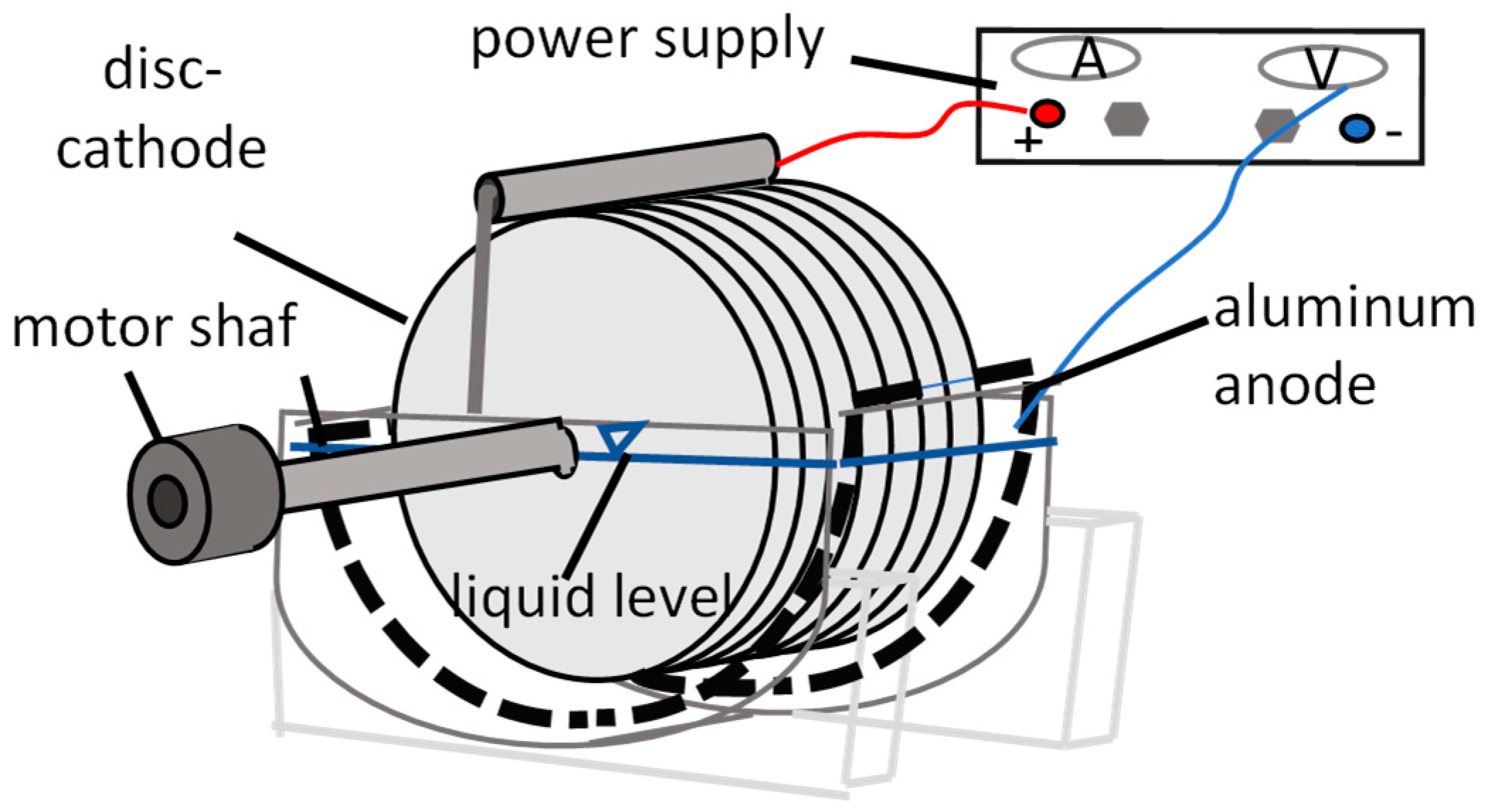
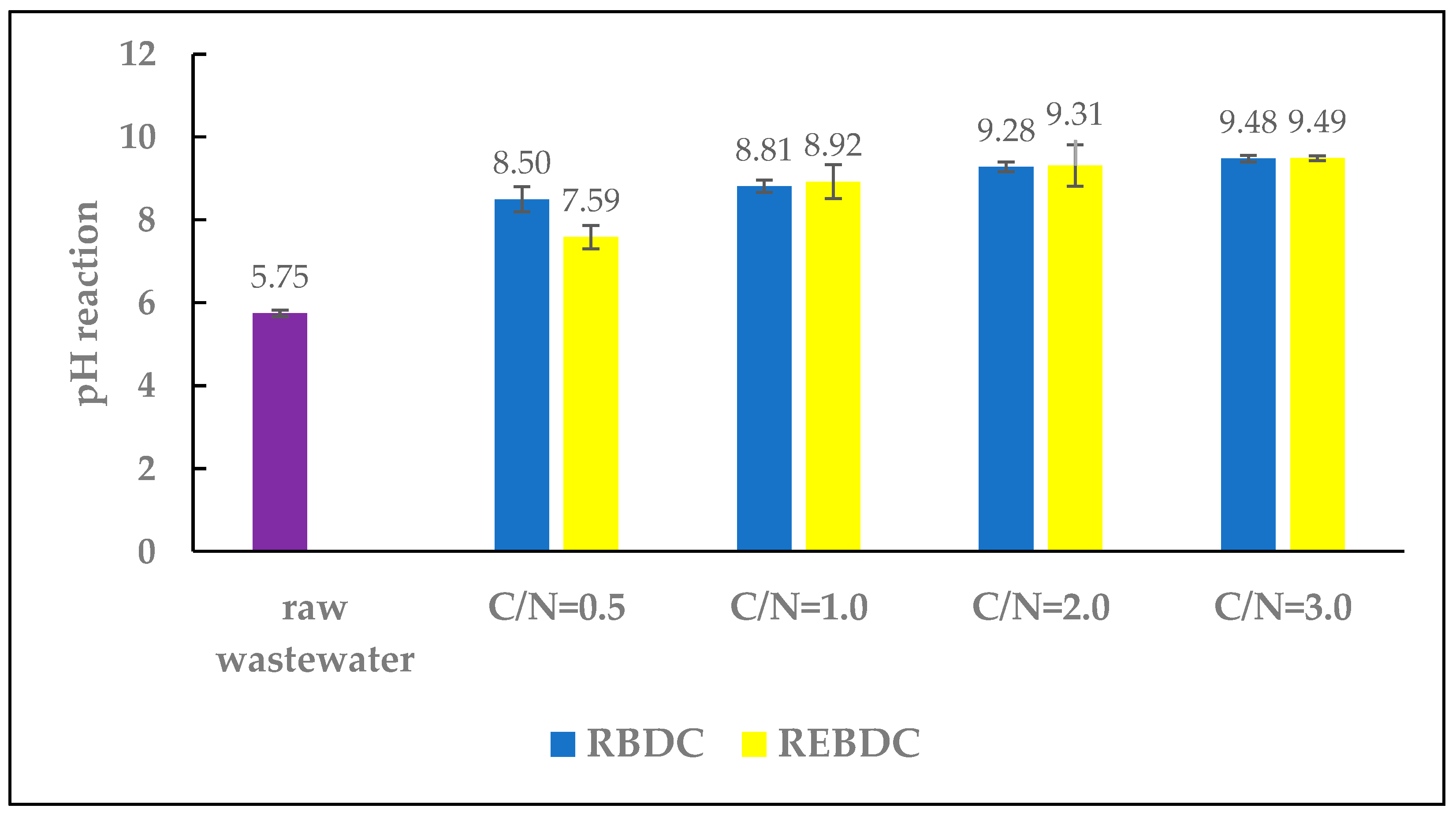
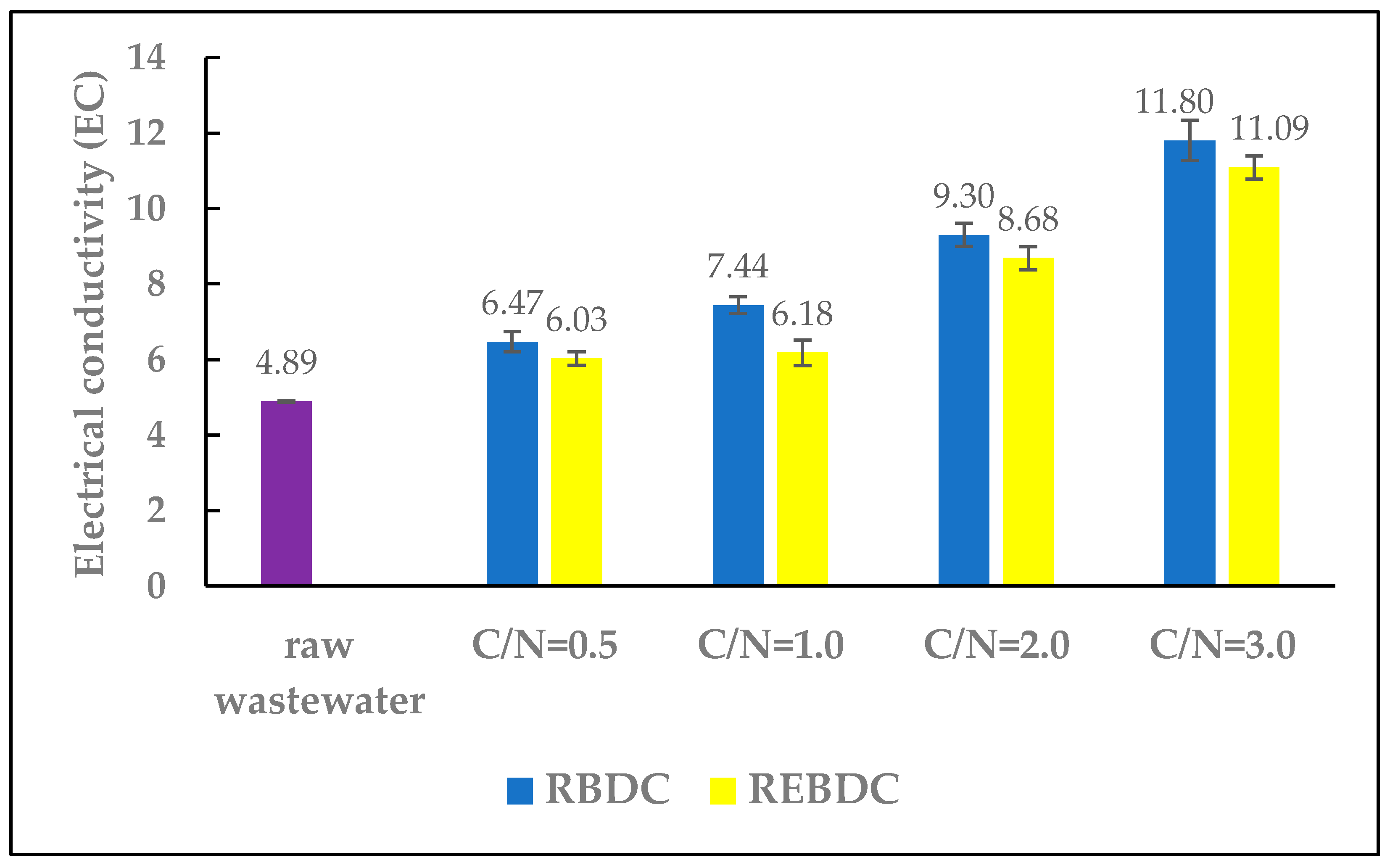
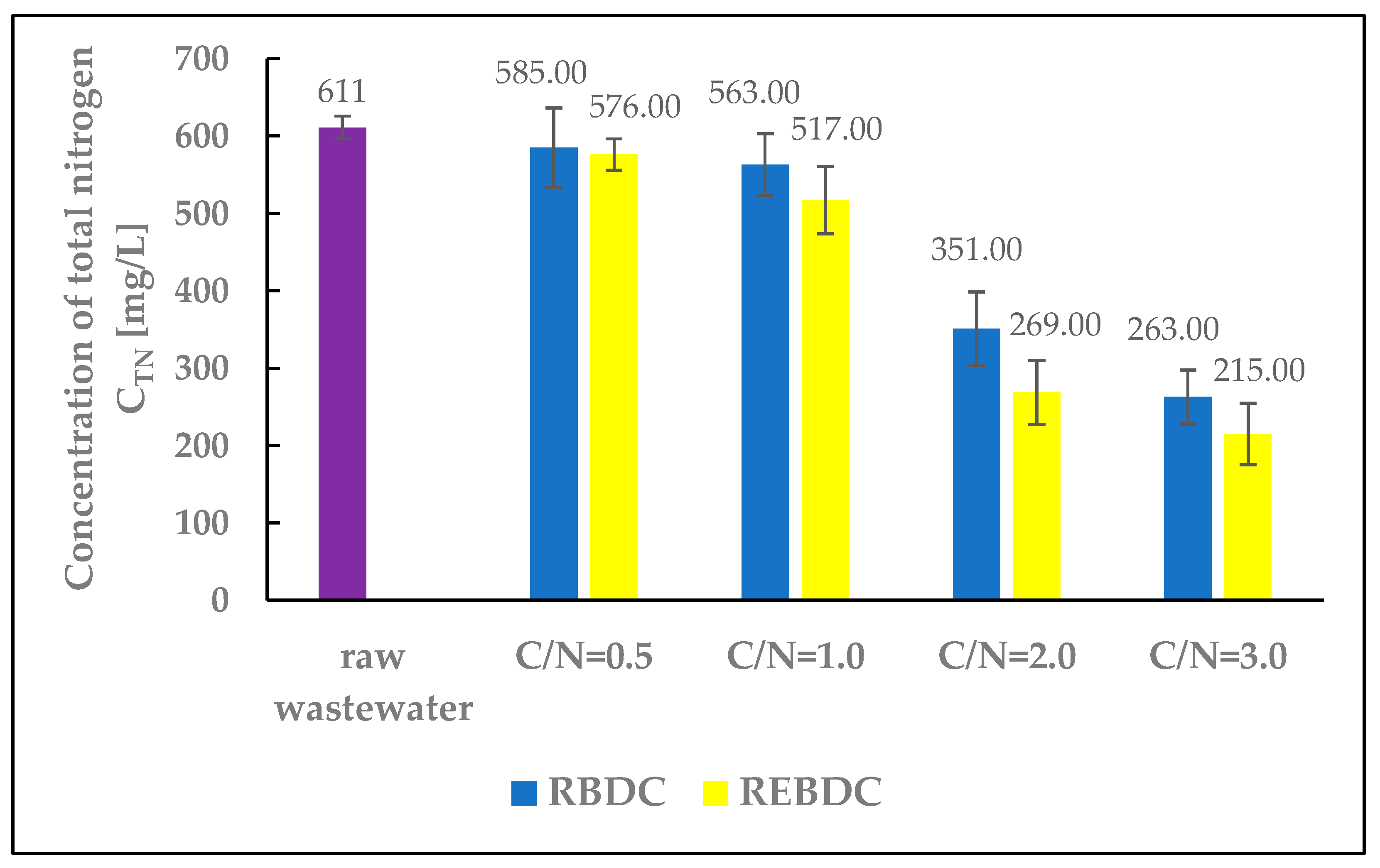
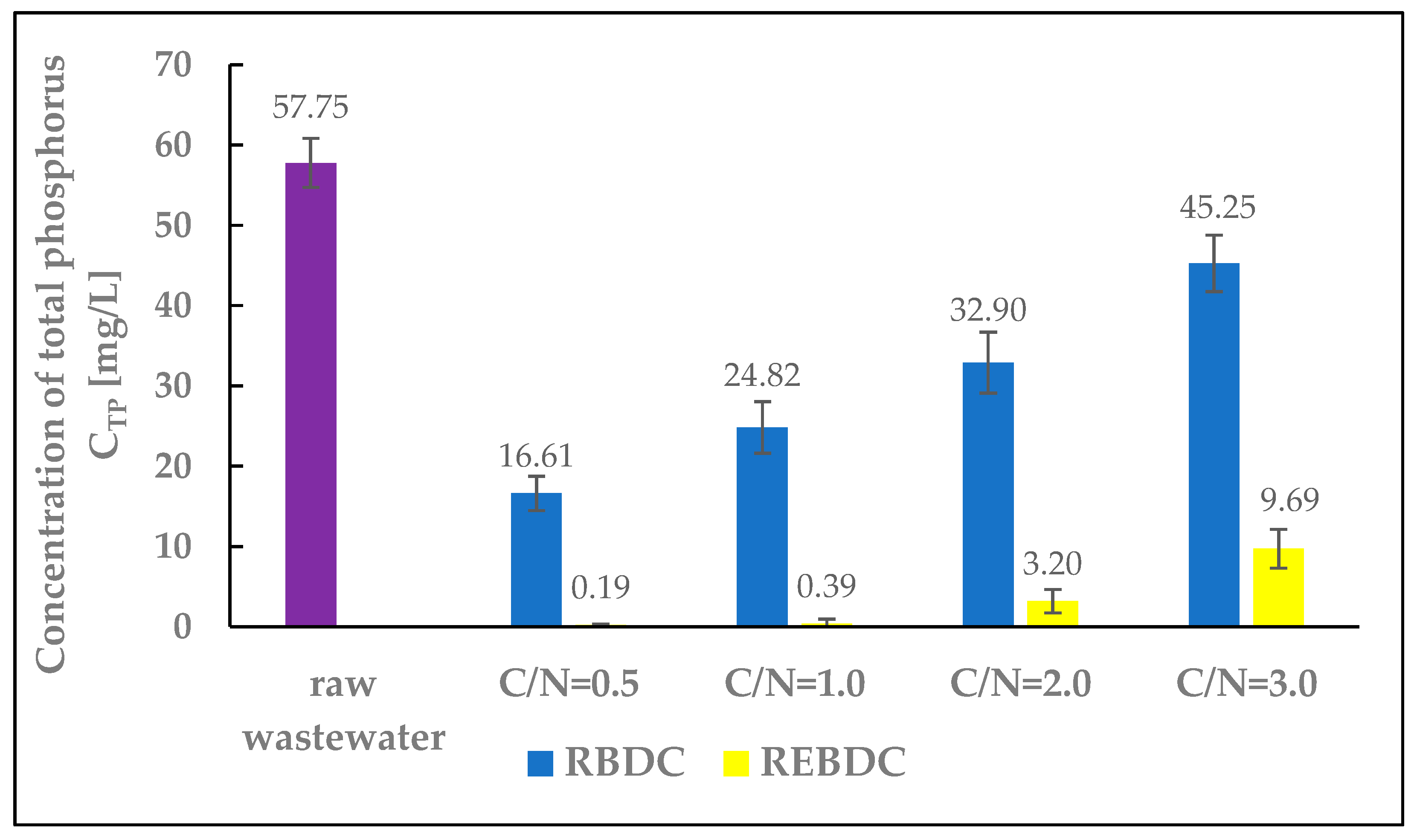
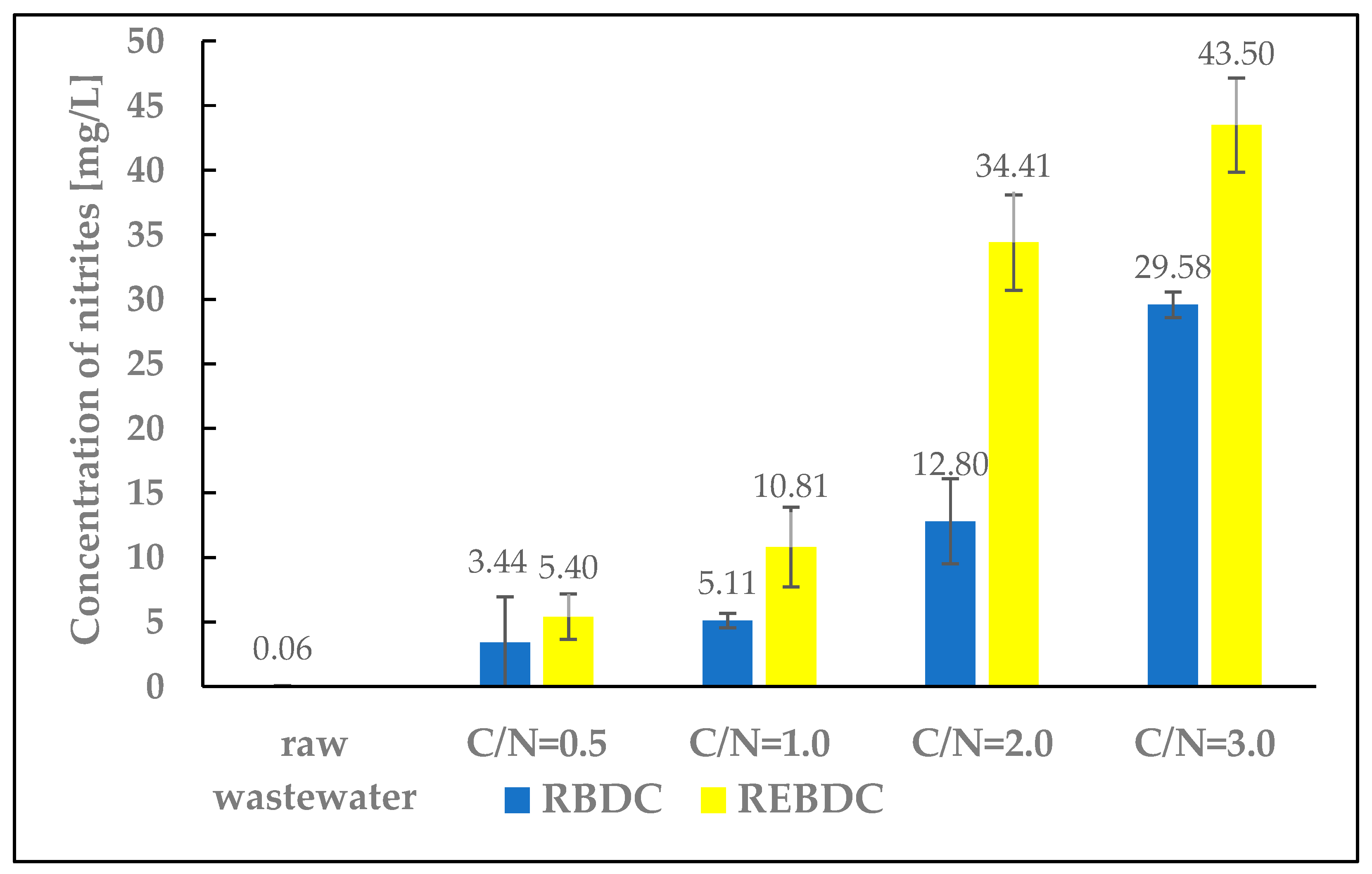
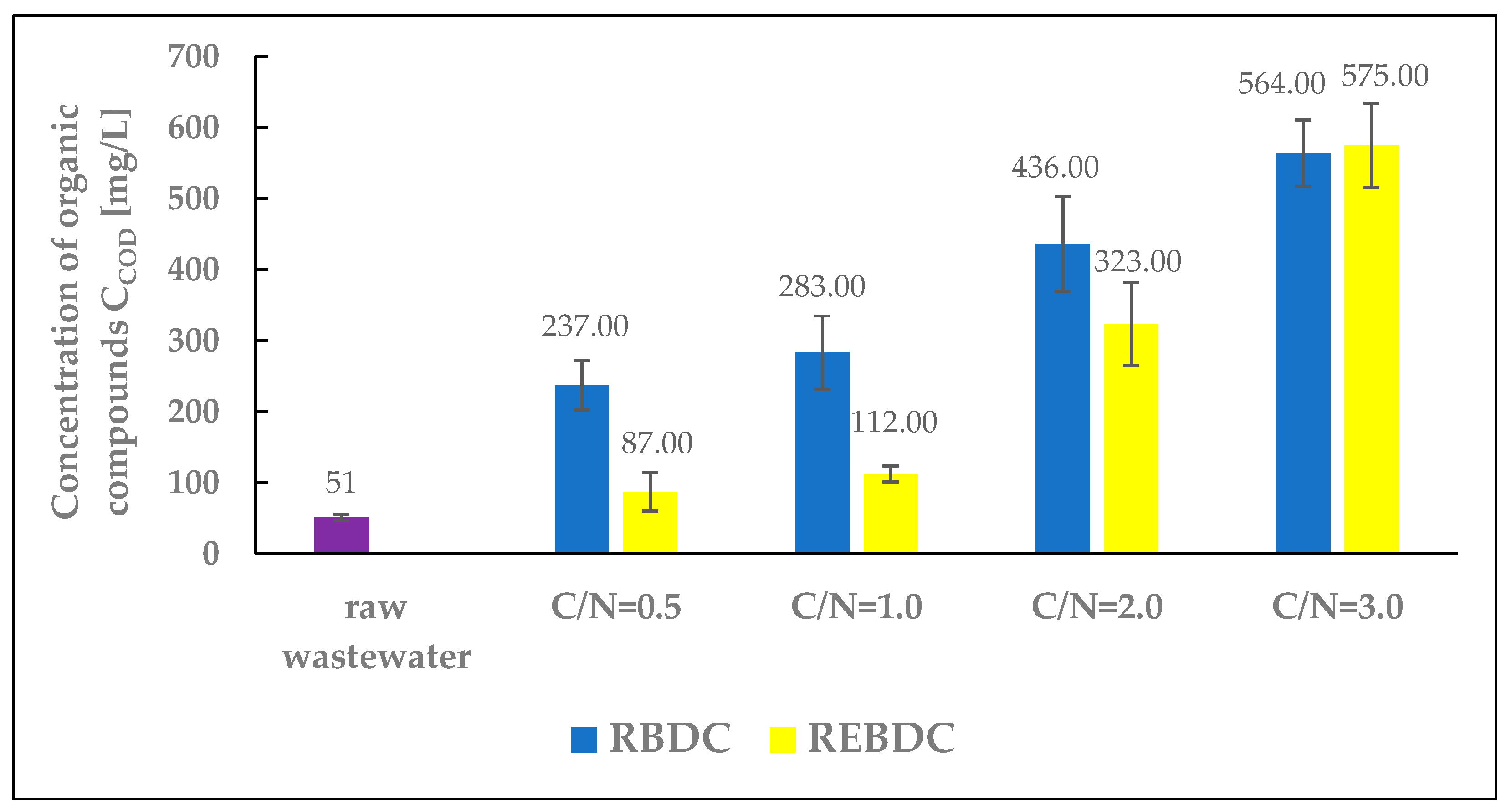
| Parameters | Value Mean |
|---|---|
| COD [mg O2/L] | 51.45 ± 4.45 |
| TOC [mg C/L] | 15.64 ± 1.41 |
| Total nitrogen [mg N/L] | 610.73 ± 14.89 |
| Nitrate [mg N/L] | 609.98 ± 11.52 |
| Ammonium nitrogen [mg N/L] | 0.69 ± 0.25 |
| Nitrite [mg N/L] | 0.06 ± 0.01 |
| Total phosphorus [mg P/L] | 57.75 ± 3.08 |
| pH | 5.75 ± 0.7 |
| Electrolytic conductivity [mS/cm] | 4.89 ± 0.03 |
| Parameter | Values |
|---|---|
| Number of discs [pcs.] | 8 |
| Disc diameter [cm] | 22 |
| The total area of the discs [m2] | 0.56 |
| Submergence of the discs [%] | 40 |
| Flow chamber volume [L] | 2.0 |
| Rotation speed [rpm] | 10 |
| Parameter | Phase I—Biological Reactor: Rotating Biological Disc Contactor (RBDC) | Phase II—Electro-Biological Reactor: Rotating Electro-Biological Disc Contactor (REBDC) |
|---|---|---|
| HRT [h] | 24 | 24 |
| C/N [gC/gN] | 0.5, 1.0, 2.0, 3.0 | 0.5, 1.0, 2.0, 3.0 |
| J [A/m2] | - | 2.5 |
Disclaimer/Publisher’s Note: The statements, opinions and data contained in all publications are solely those of the individual author(s) and contributor(s) and not of MDPI and/or the editor(s). MDPI and/or the editor(s) disclaim responsibility for any injury to people or property resulting from any ideas, methods, instructions or products referred to in the content. |
© 2025 by the authors. Licensee MDPI, Basel, Switzerland. This article is an open access article distributed under the terms and conditions of the Creative Commons Attribution (CC BY) license (https://creativecommons.org/licenses/by/4.0/).
Share and Cite
Rodziewicz, J.; Mielcarek, A.; Bryszewski, K.; Kwietniewski, M.; Janczukowicz, W. Limited Utilization of an External Carbon Source in a Rotating Electro-Biological Disc Contactor (REBDC). Processes 2025, 13, 3115. https://doi.org/10.3390/pr13103115
Rodziewicz J, Mielcarek A, Bryszewski K, Kwietniewski M, Janczukowicz W. Limited Utilization of an External Carbon Source in a Rotating Electro-Biological Disc Contactor (REBDC). Processes. 2025; 13(10):3115. https://doi.org/10.3390/pr13103115
Chicago/Turabian StyleRodziewicz, Joanna, Artur Mielcarek, Kamil Bryszewski, Marian Kwietniewski, and Wojciech Janczukowicz. 2025. "Limited Utilization of an External Carbon Source in a Rotating Electro-Biological Disc Contactor (REBDC)" Processes 13, no. 10: 3115. https://doi.org/10.3390/pr13103115
APA StyleRodziewicz, J., Mielcarek, A., Bryszewski, K., Kwietniewski, M., & Janczukowicz, W. (2025). Limited Utilization of an External Carbon Source in a Rotating Electro-Biological Disc Contactor (REBDC). Processes, 13(10), 3115. https://doi.org/10.3390/pr13103115













